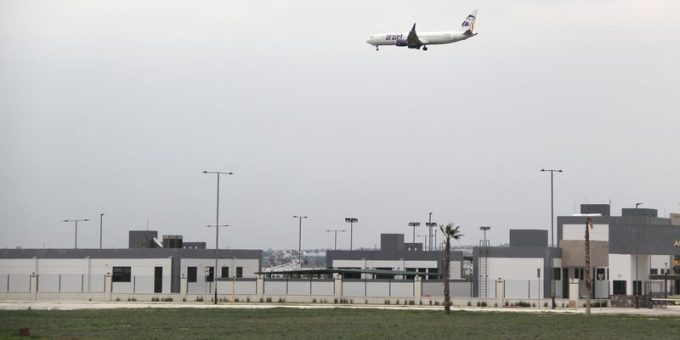The International Air Transport Association (IATA) has called for a meeting with Mexican authorities to prevent a repeat of the problems that hindered the start of freighter operations at Felipe Angeles International Airport (AIFA) last year.
As the industry prepares for the imminent expansion of Mexico City’s main airfreight hub, IATA’s regional cargo manager Americas, Rigoberto Lopez, wants the authorities and industry representatives to sit down and discuss the lessons learned from the botched start of freighter operations at AIFA. The expansion of AIFA will include seven new cargo warehouses, two ramps, and a taxiway.
However, there are concerns that the expansion may not be completed before Mexican President Andres Manuel Lopez Obrador hands over to his successor, Claudia Sheinbaum, in October. This seems ambitious considering the complexity of the project.
Rigoberto Lopez noted that it is still difficult to connect cargo from AICM (Benito Juarez International Airport) to AIFA, and security on the road remains a concern. The lengthy transit time and high cost put Mexico at a competitive disadvantage, making airfreight less attractive compared to other modes.
Lufthansa Cargo’s director in Mexico, Frank Nozinsky, said that while flows and processes have improved significantly, customs processes and transshipments still need to be accelerated, and more airlines need to be attracted to the airport.
The cargo infrastructure at AIFA needs expansion as it was already fully taken last year. One integrator has indicated that its space is inadequate. Mexico’s airfreight volume in the first five months of this year was up 7%, putting pressure on new facilities at AIFA, which is the fastest-growing Mexican airport during this period.
The demand for airfreight remains strong, according to Nozinsky. To address weight restrictions due to the altitude of the Mexican capital, Lufthansa’s daily freighter flights between AIFA and its home market stop in Guadalajara, Monterrey, or Dallas/Fort Worth on the eastbound sector.
Automotive traffic and pharmaceuticals are the strongest verticals, but electronics and e-commerce have also been going strong, supplemented by seasonal perishables. For the airline, the migration of freighters to AIFA was a challenge because it continues to run its passenger flights to AICM mainly to accommodate travellers connecting to other flights there.
A Mexican forwarder recently expressed a hope that the new government might consider allowing some freighter operations to return to AICM. However, this is unlikely, and the incoming administration appears more open to dialogue with industry than the current one, say observers.
The airports are all controlled by the military, and “dialogue with them is not always customer-oriented,” commented one industry executive. How far any dialogue may go does not rest entirely with the new president. The expansion of AIFA will be a key factor in determining the future of airfreight operations in Mexico City. However, there are concerns that the expansion may not be completed on time. The demand for airfreight remains strong, and the industry is bracing itself for the imminent expansion of the capital city’s designated airfreight hub.
The expansion will include seven new cargo warehouses, two ramps, and a taxiway. However, there are concerns that the expansion may not be completed before Mexican President Andres Manuel Lopez Obrador hands over to his successor, Claudia Sheinbaum, in October. This seems ambitious considering the complexity of the project.
Rigoberto Lopez noted that it is still difficult to connect cargo from AICM (Benito Juarez International Airport) to AIFA, and security on the road remains a concern. The lengthy transit time and high cost put Mexico at a competitive disadvantage, making airfreight less attractive compared to other modes.
Lufthansa Cargo’s director in Mexico, Frank Nozinsky, said that while flows and processes have improved significantly, customs processes and transshipments still need to be accelerated, and more airlines need to be attracted to the airport.
The cargo infrastructure at AIFA needs expansion as it was already fully taken last year. One integrator has indicated that its space is inadequate. Mexico’s airfreight volume in the first five months of this year was up 7%, putting pressure on new facilities at AIFA, which is the fastest-growing Mexican airport during this period.
The demand for airfreight remains strong, according to Nozinsky. To address weight restrictions due to the altitude of the Mexican capital, Lufthansa’s daily freighter flights between AIFA and its home market stop in Guadalajara, Monterrey, or Dallas/Fort Worth on the eastbound sector.
Automotive traffic and pharmaceuticals are the strongest verticals, but electronics and e-commerce have also been going strong, supplemented by seasonal perishables. For the airline, the migration of freighters to AIFA was a challenge because it continues to run its passenger flights to AICM mainly to accommodate travellers connecting to other flights there.
A Mexican forwarder recently expressed a hope that the new government might consider allowing some freighter operations to return to AICM. However, this is unlikely, and the incoming administration appears more open to dialogue with industry than the current one, say observers.
The airports are all controlled by the military, and “dialogue with them is not always customer-oriented,” commented one industry executive. How far any dialogue may go does not rest entirely with the new president.
Source: The Load Star






